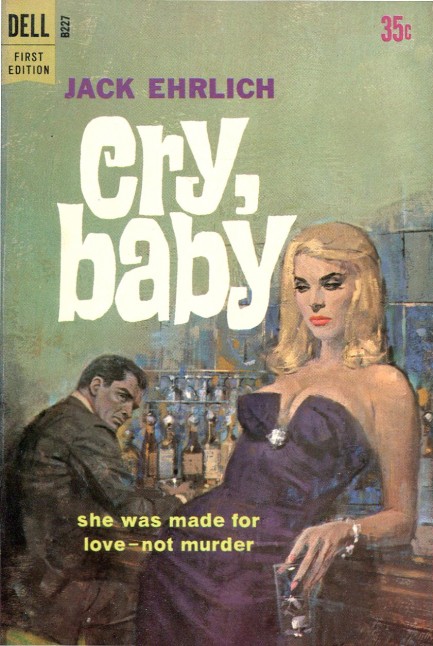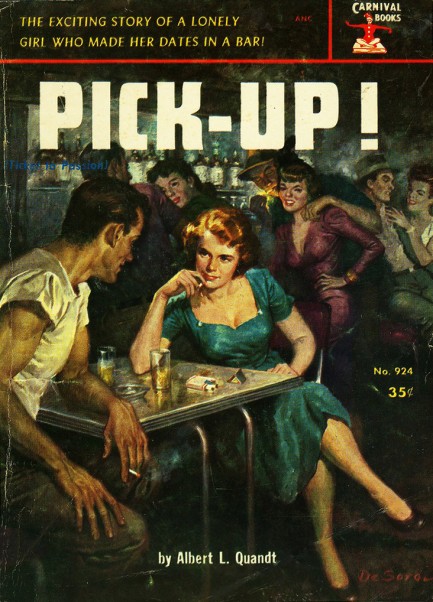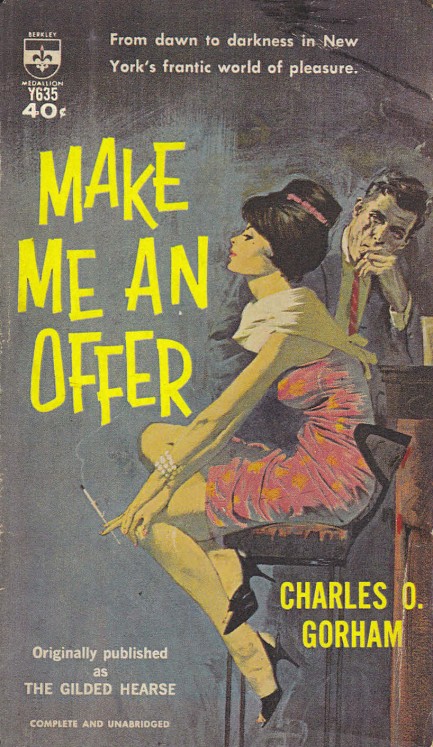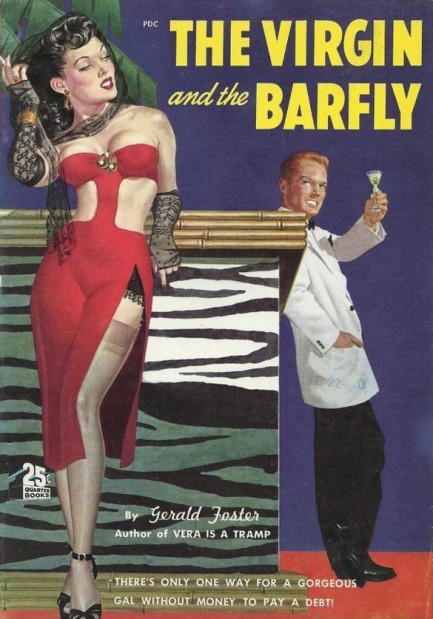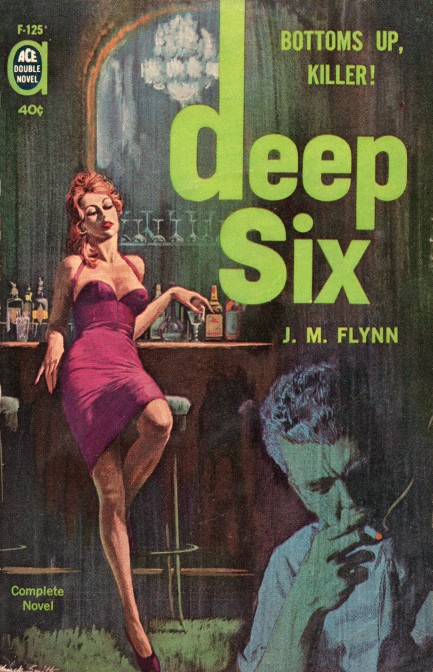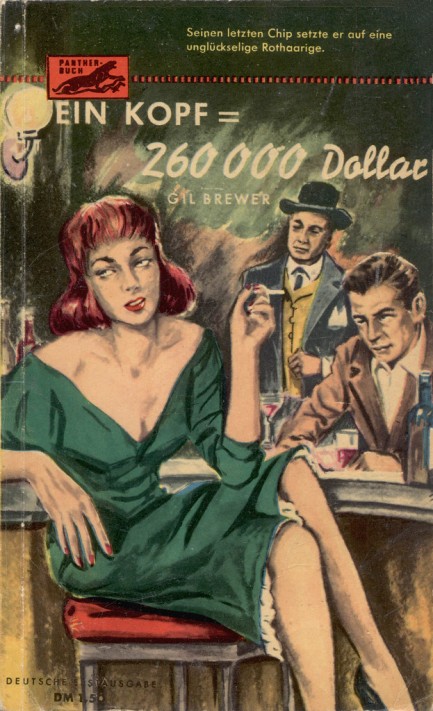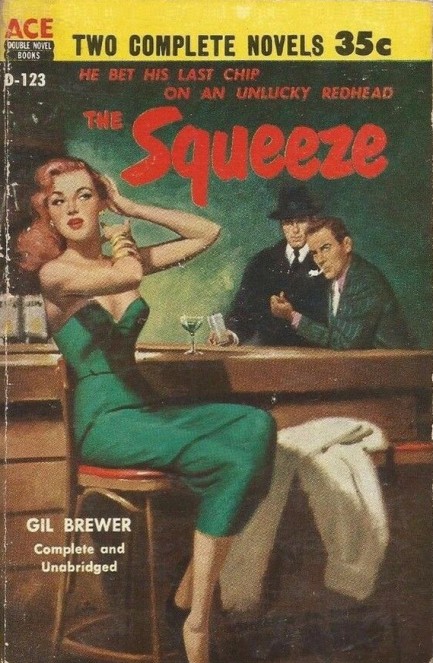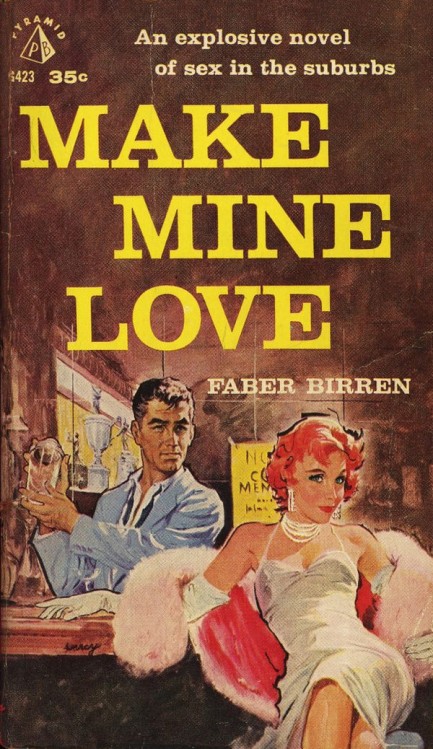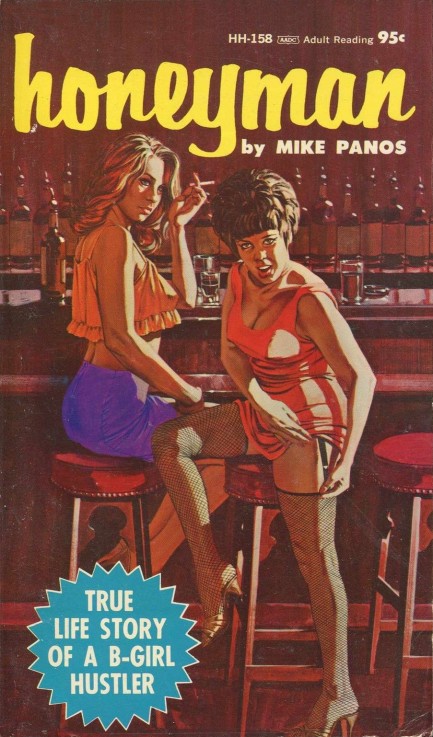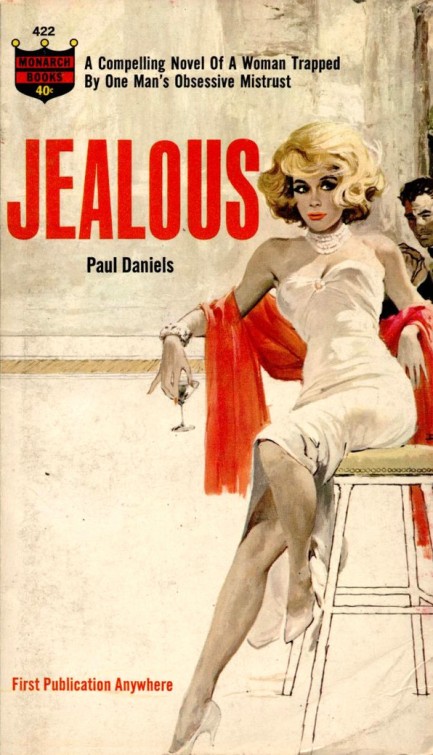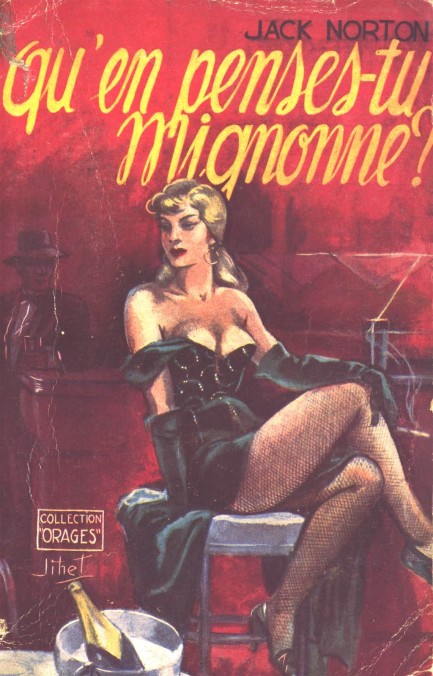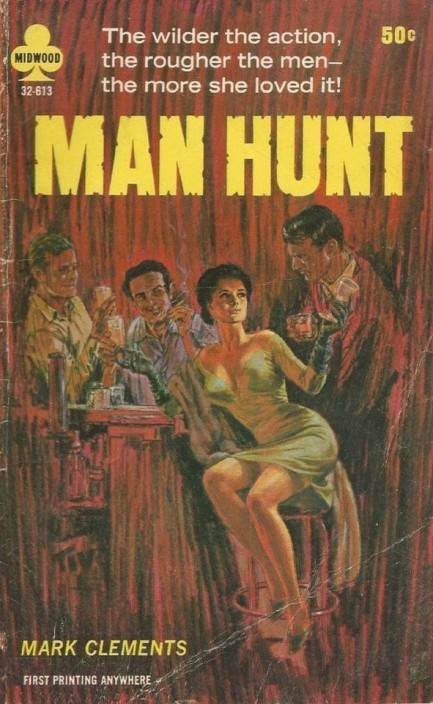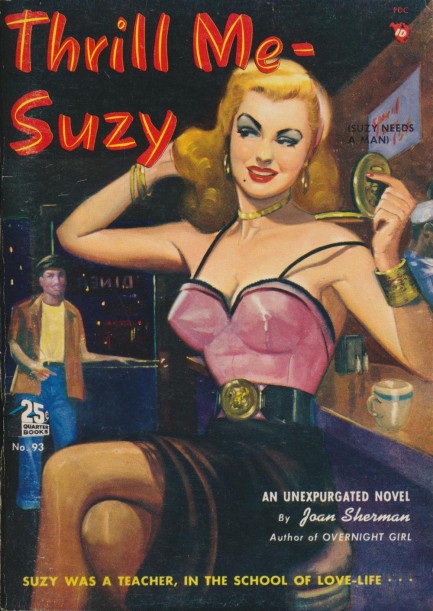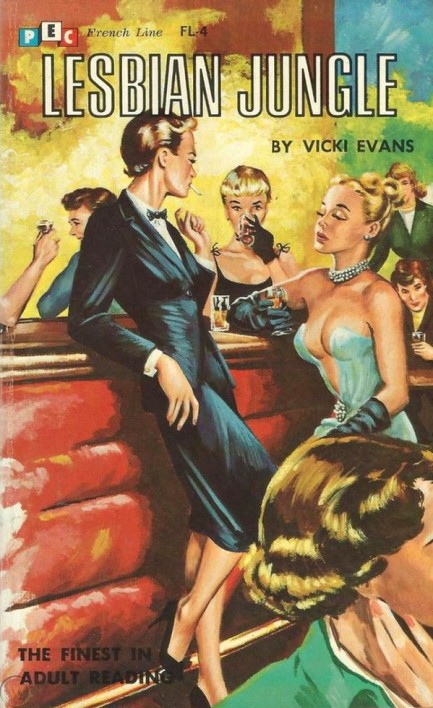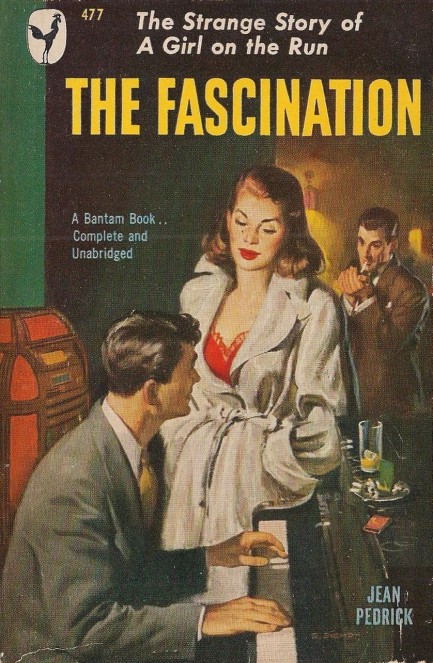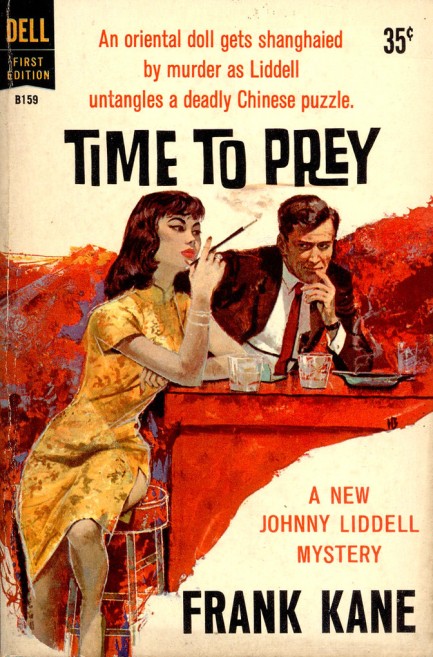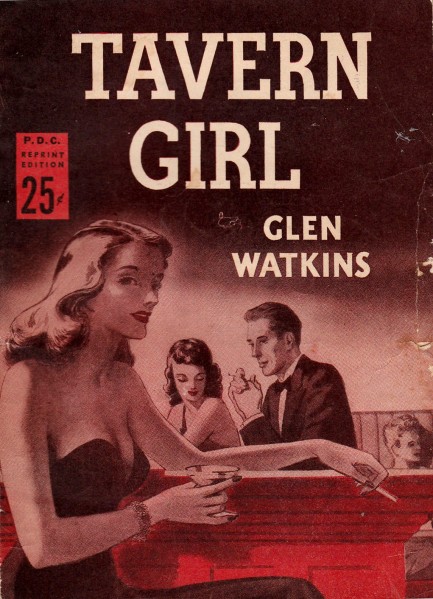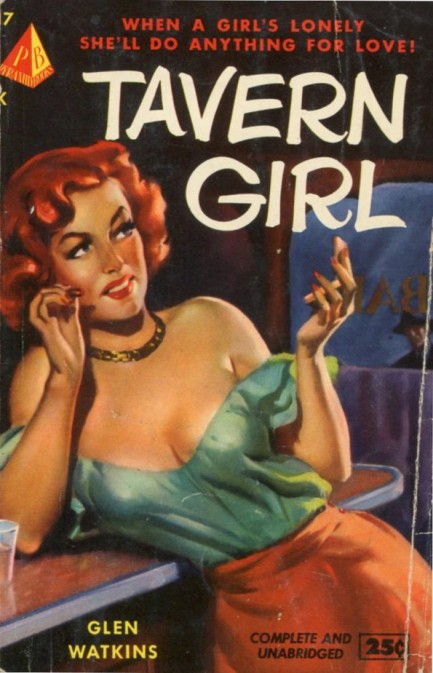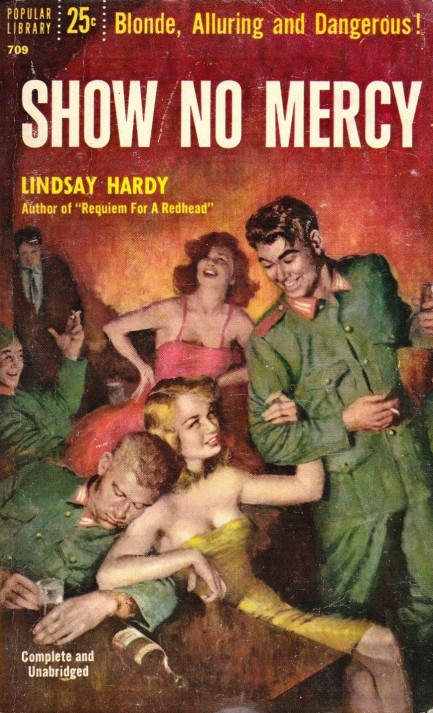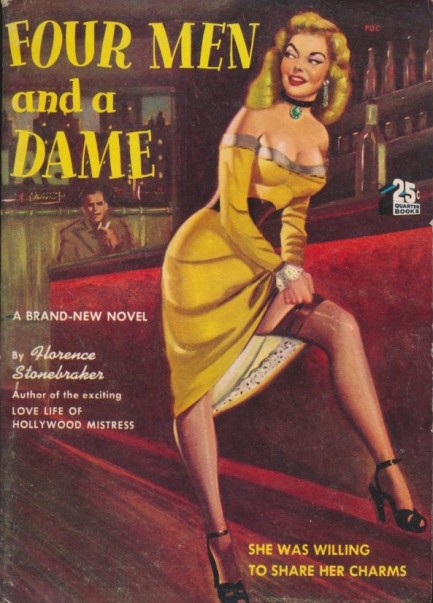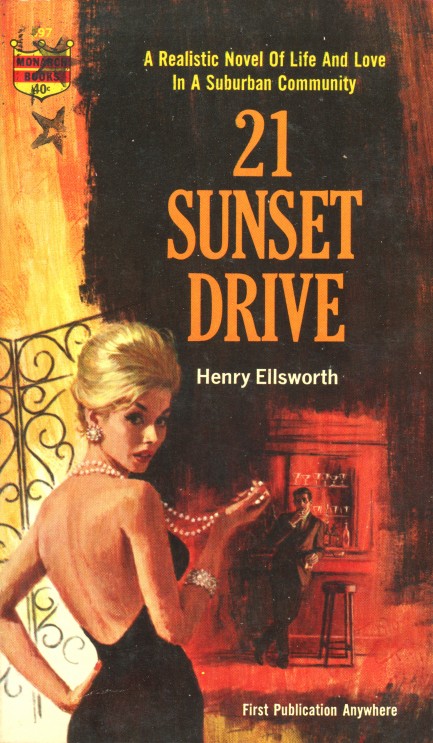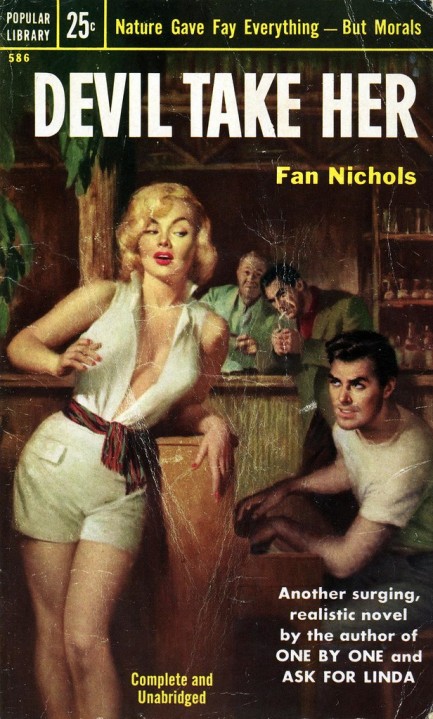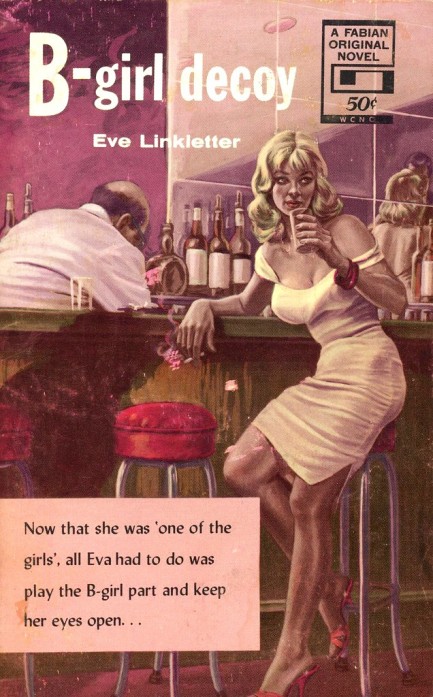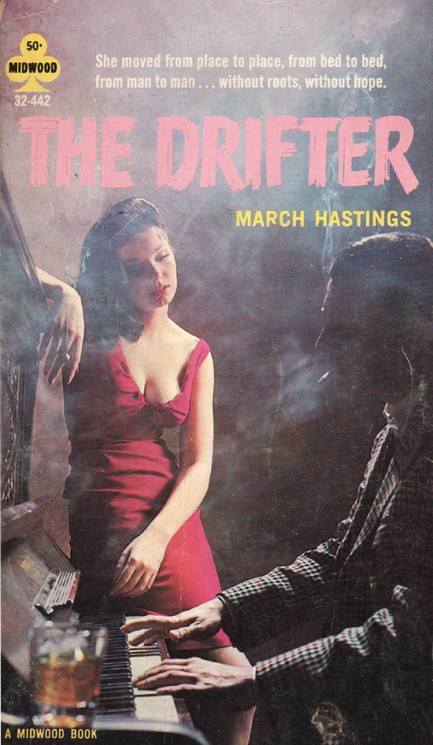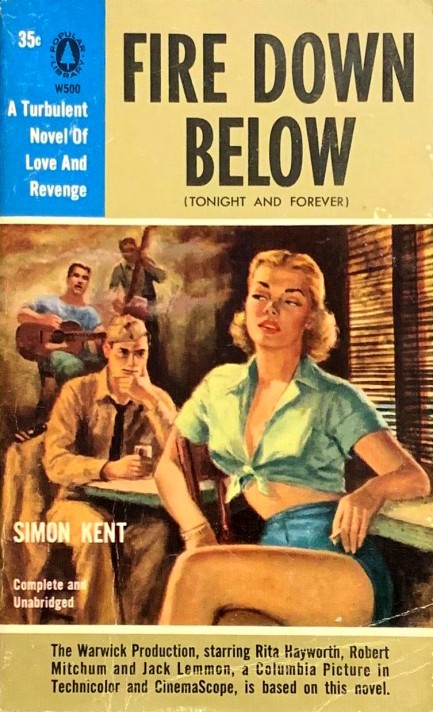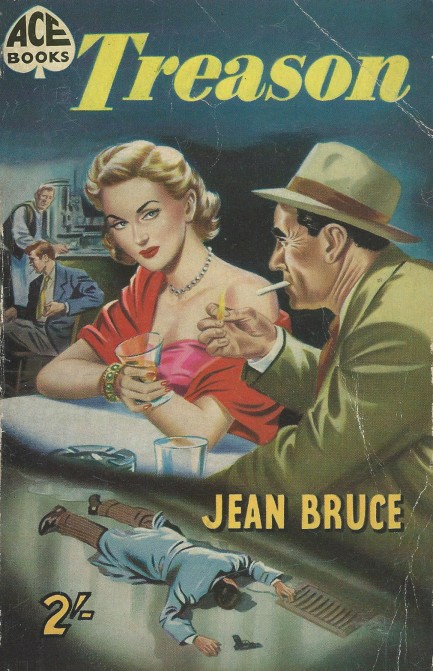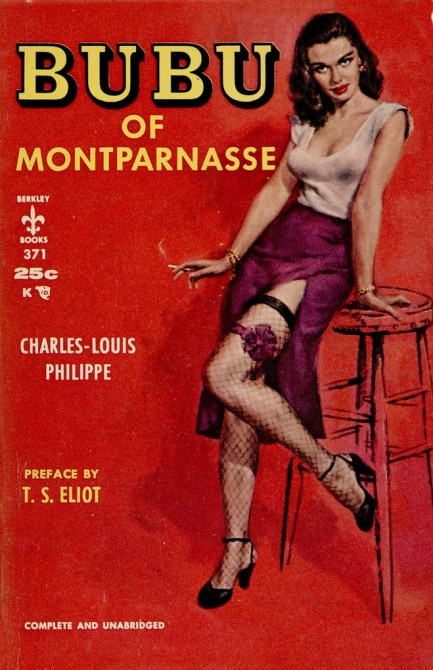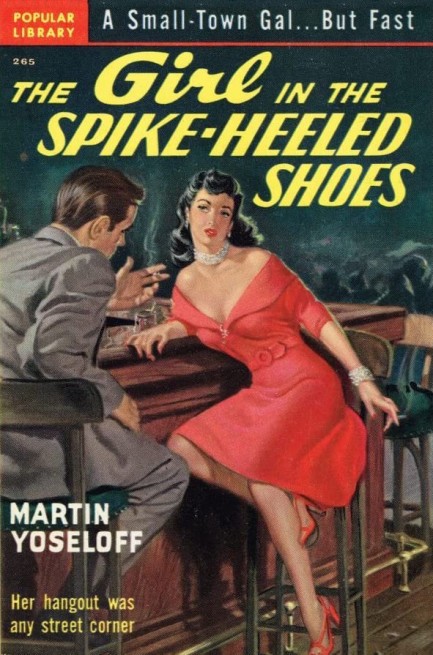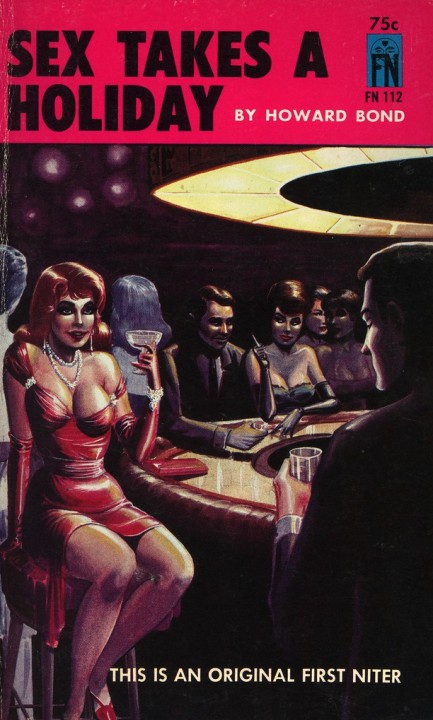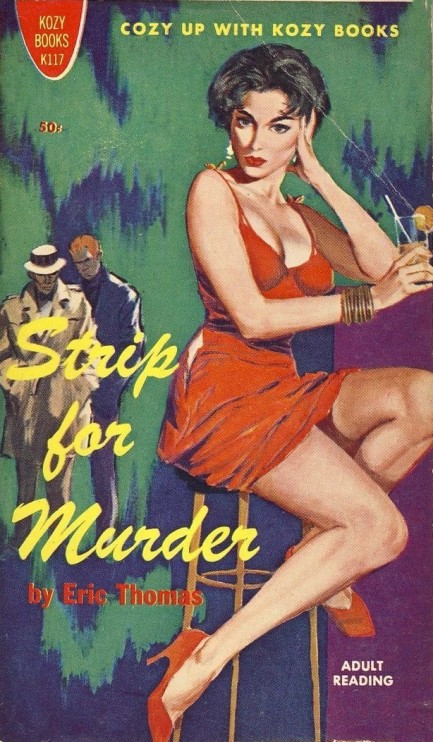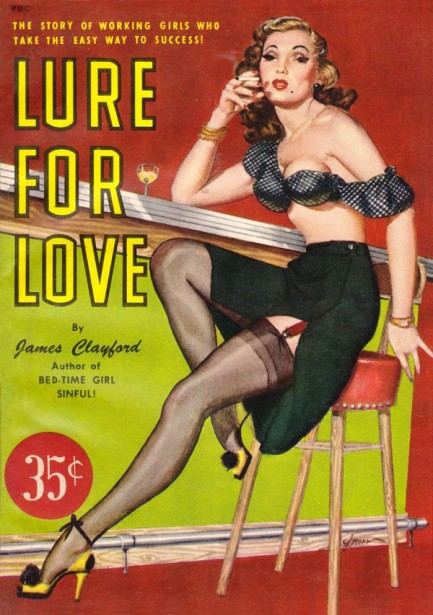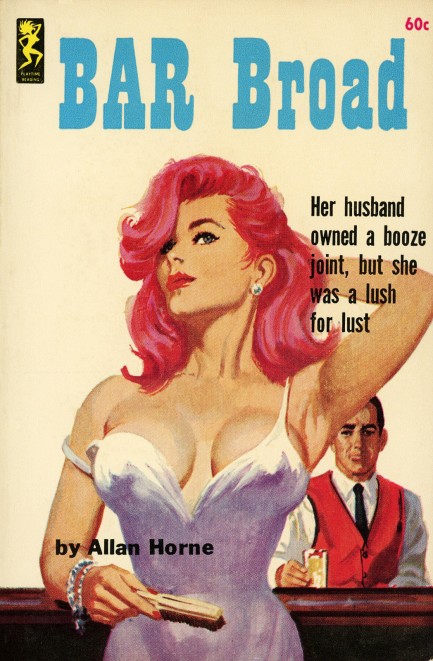 That's a tempting invitation, but the hospital has a very strict code of ethics. So we'll have to do it at your place. 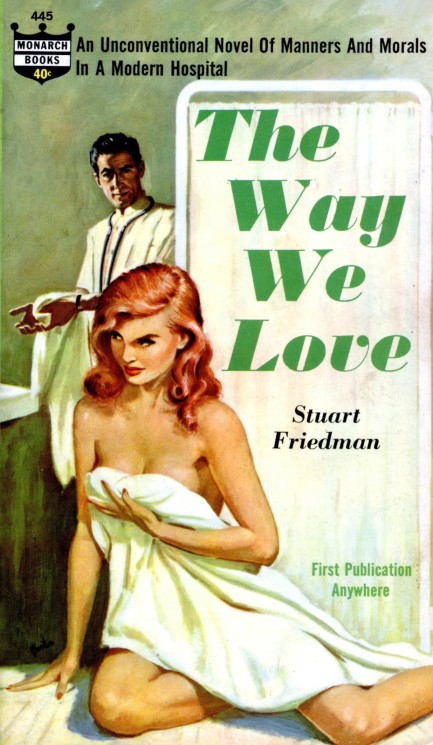
Above: a Harry Barton cover for Stuart Friedman's 1960 sleazer The Way We Love, an “unconventional novels of manners and morals in a modern hospital.” Uh huh. We bet we know what's unconventional about it. Something of note here: the cover for Friedman's 1962 effort The Surgeons is a near-duplicate of this, but painted by Harry Schaare. We wonder if that's chance, or if Monarch's art director influenced the final product. Curious. We have a lot more medical covers in the website. See a small portion of them here, here, here, here, here, and here.
 Everyone except me ended up hospitalized, jailed, or married. So yeah, it was pretty wild. 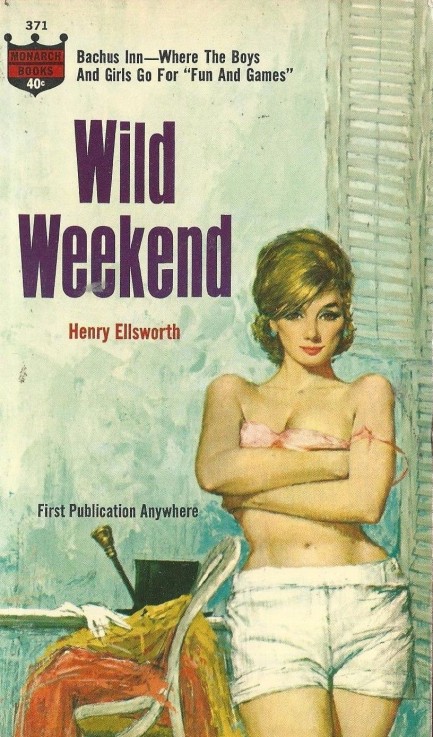
Above: a Monarch Books paperback, Wild Weekend by Henry Ellsworh, about the throngs that flee New York City during summer weekends to the adjacent wilds, in this case to the Bacchus Inn, and the various intrigues and peccadilloes that result. It was published in 1963, and the art, while it resembles that of Robert Schultz, is uncredited.
 Toto we’re not in Africa anymore. 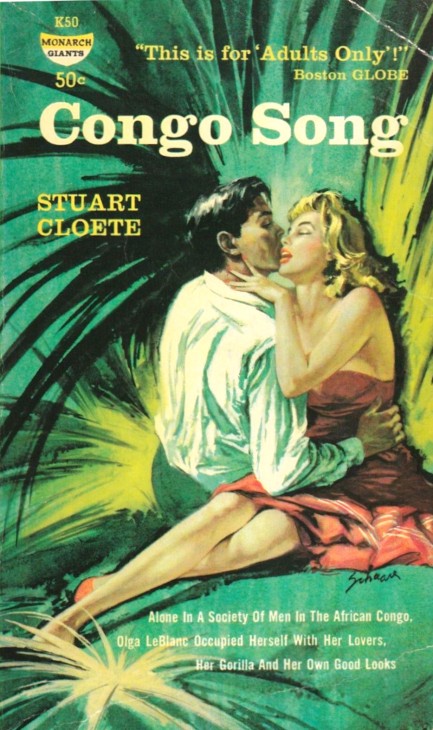
We said we'd get back to Stuart Cloete’s 1943 jungle drama Congo Song, and here we are. The book has been reprinted often, including in the 1958 Monarch edition you see above, with Harry Schaare cover art. Its popularity certainly owed something to the fact that it was another book that nurtured popular Western stereotypes about life in Africa, including that it attracted decadent and damaged whites whose weaknesses were inevitably amplified by the deep, dark, primitive, savage, mysterious continent. You've read something like this once or twice, we bet, thanks to Hemingway and others, though Cloete, who was from South Africa, writes in an entirely different style than Papa:
This was the Congo song: the song of sluggish rivers, of the mountains, the forests; the song of the distant, throbbing drums, of the ripe fruits falling, of the mosquitoes humming in the scented dusk; the song of Entobo, of the gorilla, and the snake. The song no white man would ever sing. The wild dogs cry out in the night as they grow restless, longing for some solitary company. Oops—that last sentence is from the Toto song “Africa.” Don't know how that slipped in there. Anyway, Congo Song unfolds in the months before the start of World War II. Cloete’s characters are diverse, with his main creation being Olga le Blanc, the only woman living in an isolated outpost called Botanical Station with several men, including her husband, a researcher who spends a lot of time away. Olga is a vamp who must make other men fall in with love her, and her affections don't end at homo sapiens sapiens—she has a gorilla, unsubtly named Congo, that she nursed at her own breast when it was an infant. Cloete’s symbolism is pretty thick milk. Erudite conversation, circular philosophizing, seductions, and secrets abound at Botanical Station. One of the other main characters is an American named Henry Wilson who has been sent by handlers in Nairobi to keep an eye on the doings of a German spy named Fritz von Brandt. Olga, meanwhile, spies on von Brandt for the English—sometimes from his bed. Other characters have less purpose, and many eccentricities. One drinks too much. Another sleeps with teenaged Congolese girls under the guise of employing them as domestics. The researcher seems to love trees more than Olga. Nobody is particularly happy. Who is who? Who wants what? There's another spy, who we won't name, a machine-like man, asexual, immune even to Olga: Women were the weakness of so many. Money, luxury, power, all resolved themselves finally into women. That was where the money went. That was what the power was used to obtain. How lucky he was to have been born without sexual feelings. All the duplicity in Congo Song derives from the looming war in Europe, but there's also another driver: “Under all this,” Olga observes, “is the never-ending fight for the riches of Africa.”
Despite all the dinners, safaris, subterfuges, and soliloquies—or maybe because of the soliloquies—the book doesn't gather momentum until about page two-fifty, after a fatal accident. Then things move fast enough to cause whiplash. Death comes by various methods, none of them banal. And of course there's still that gorilla. He lives in the house with the le Blancs, but Olga lets him loose regularly. Surely that'll end with limbs separated from bodies and blood on the louvered doors. And Cloete clearly must—absolutely must—squeeze in a little lethal witch-doctoring. No more plot hints. However, it isn't a spoiler to reveal that since Cloete follows the basic blueprint of other books of this type, at least a character or two eventually flee for modern civilization. But they'll remember Congo with bittersweet nostalgia—primarily during a maudlin denouement drawn out over several chapters. But it's understandable—it's not easy to let go of such beauty and horror. Not easy to let go of Congo Song either. It wasn't perfect, but it was very interesting. It’s gonna take a lot to take me awaaaay from yoooou… There’s nothing that a hundred men or moooore could ever doooo… I bless the rains down in Aaaafricaaa… 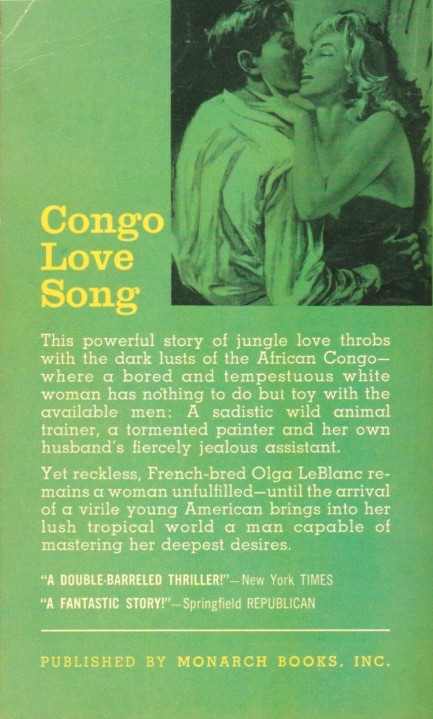
 Of course you were the first. Geez. Why does every guy ask the same question? 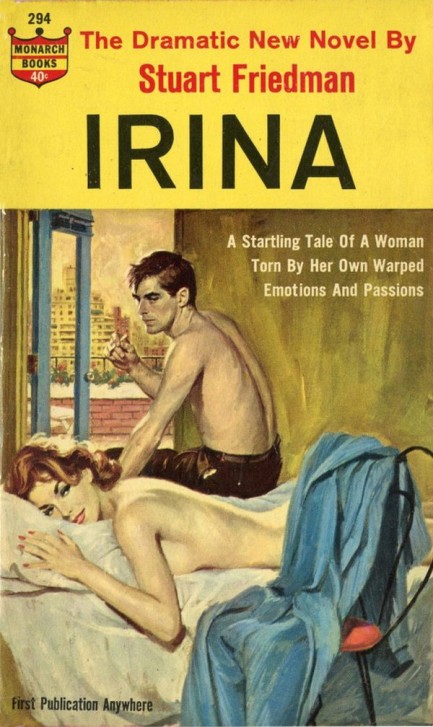
Above: a very nice Tom Miller cover for Stuart Friedman's novel Irina, from Monarch Books, copyright 1963. The maxim, “Don't ask don't tell,” would seem to apply here.
 This is nothing. When I get really mad I grow to enormous size and destroy entire city blocks. 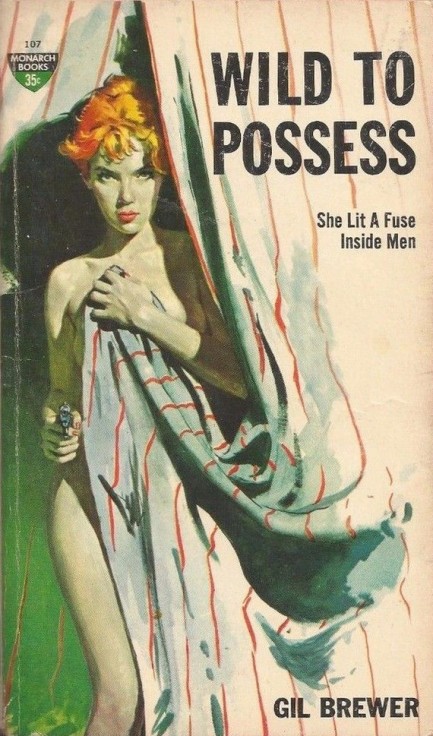
There's getting into trouble, getting into serious trouble, and getting into ridiculous trouble. In Gil Brewer's 1959 thriller Wild To Possess, the main character Lew Brookbank finds his wife and her lover murdered, and, thinking he might get blamed, panics and disposes of the bodies. Trouble. Later he overhears two people plotting a kidnapping and murder and decides that if he robs them of the two-hundred-fifty grand they expect to profit he can start a new life. But he's a drunk, so signs don't point to success. Serious trouble. Then a man turns up determined to send Lew to the electric chair for the two murders he never committed. Ridiculous trouble.
In an effort to make this loony plot believable Brewer shuffles the timeline: it opens with Lew overhearing the pair talking about the kidnap/murder, then the narrative backtracks and reveals that his wife's murder is why he became an alcoholic basket case. It actually works, sort of, which is good, because bizarre things keep happening, some of which involve a trapdoor above his bed. We won't even explain it. This is mid-level Brewer, quality-wise. While it has some fun ideas, it could have used extra detailing from a dedicated editor. But it's worth a read, especially this Monarch edition with iconic Robert Maguire cover art of an orange-topped, Hulk green femme fatale. More Gil to come.
 She's going to get rich even if it costs everything you have. 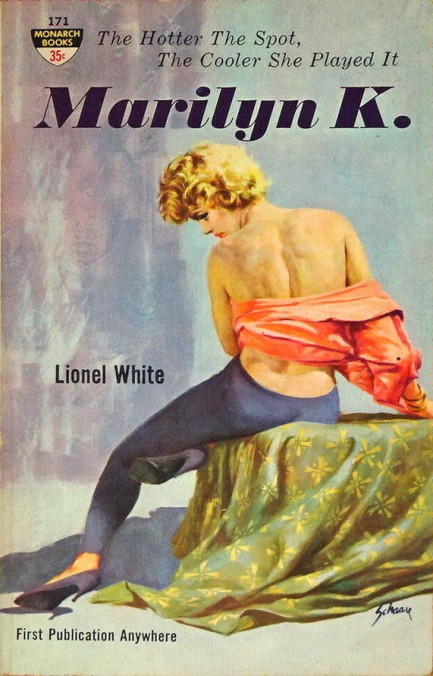
Lionel White is a solid author, one we've enjoyed several times. In Marilyn K. he sets a challenge for himself. He takes the hoariest cliché—a stranded woman by the roadside with a suitcase—and runs with it as far and fast as he can. She's a mobster's girlfriend, the suitcase contains $350,000, she may have killed someone, she's possibly being chased by dangerous people, the hero should ditch her but she's a real sexpot, etc., etc. This is a film noir-style story in which the protagonist finds himself in deeper quicksand with each passing chapter. And as in film noir, he's moth-to-flame with a femme fatale who seems certain to destroy him. He needs to figure out if he's being set up, avoid murderous mobsters, try not to get arrested, and keep his dick in his pants long enough to have a good long think about all of the preceding. The last challenge is the hardest by far. In the end there's a twist—more of a switcheroo—that you'll see through immediately, after which the book resolves in suitably noir fashion. Despite some lapses this is a decent tale. But when White is on form, he's great. Marilyn K. is from 1960, and the cover art is by Harry Schaare.
 Well, duh, of course we used you until you were sad and broken. What the hell do you think we learn in business school? 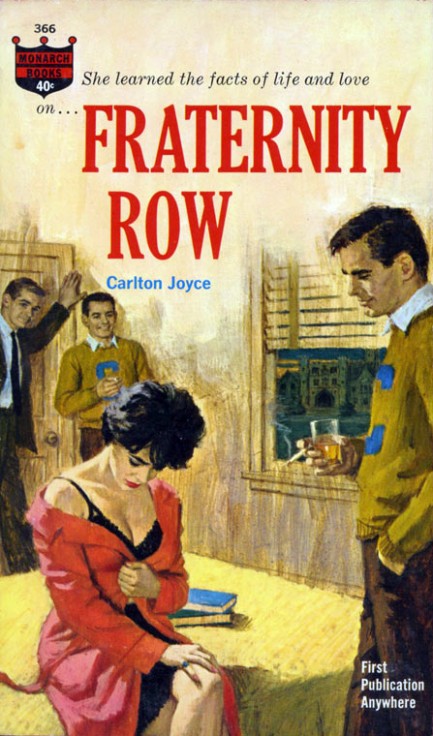
Above, a cover for Carlton Joyce's campus sleazer Fraternity Row, 1963, about a charming sociopath named Chaz Graycen III, king of the hotshot Delta Mu fraternity, who knows no bounds of taste nor conscience when it comes to using people for his own benefit. So basically it's a deadly accurate take on entitled one percenters. The cover art is by Tom Miller, who we did a little feature on here.
 Actually, the flap on my bikini does slim the hips. It also hides pistols. Now get your hands up, idiot. 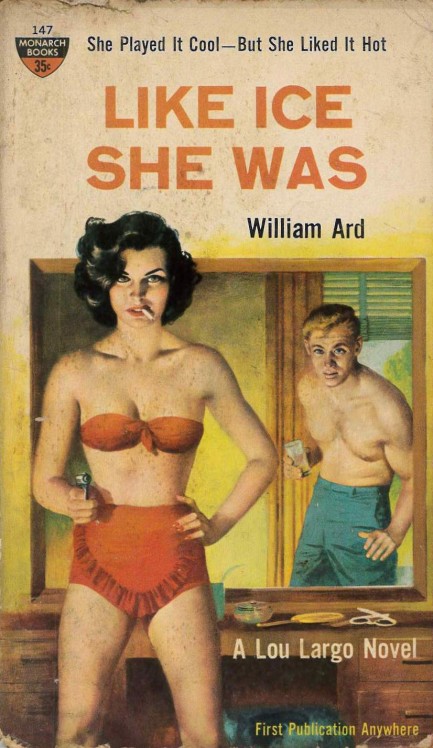
William Ard's Like Ice She Was stars his detective creation Lou Largo in a missing persons case. He's looking for a former prostitute who robbed a Montreal casino owner and fled to Miami. He finds her, but the situation escalates to murder and an attempted frame-up. This character was supposed to tentpole a series, and it did, but this was the second and last Largo written by Ard, as he died after writing it. The books thereafter were ghost written by Lawrence Block, and later John Jakes. Like Ice She Was is copyright 1960, and the Monarch Books cover guide has the art as uncredited, which is a shame.
 Well, its only fair. Your husband backed his car over my wife's rose bushes last year. 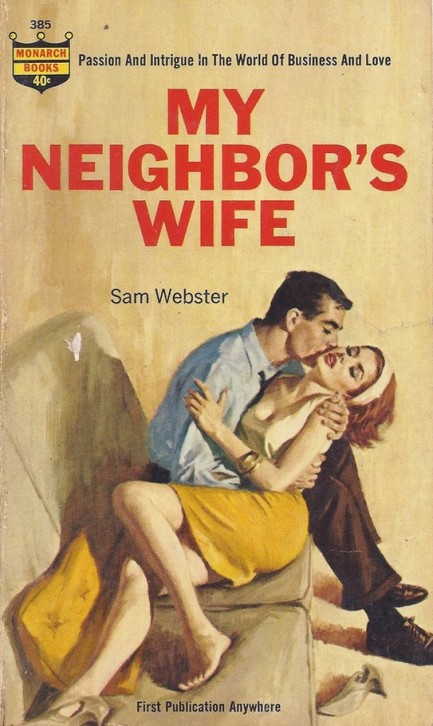
There's no end to suburban misadventures in mid-century fiction. In Sam Webster's My Neighbor's Wife, a sales manager at a steel company develops an interest in an employee's wife, so he gives the employee a traveling position and tries out some positions with the wife. Webster was a pseudonym for author Ben Haas, and this is copyright 1963 with Tom Miller cover art.

|
 |

The headlines that mattered yesteryear.
2003—Hope Dies
Film legend Bob Hope dies of pneumonia two months after celebrating his 100th birthday. 1945—Churchill Given the Sack
In spite of admiring Winston Churchill as a great wartime leader, Britons elect
Clement Attlee the nation's new prime minister in a sweeping victory for the Labour Party over the Conservatives. 1952—Evita Peron Dies
Eva Duarte de Peron, aka Evita, wife of the president of the Argentine Republic, dies from cancer at age 33. Evita had brought the working classes into a position of political power never witnessed before, but was hated by the nation's powerful military class. She is lain to rest in Milan, Italy in a secret grave under a nun's name, but is eventually returned to Argentina for reburial beside her husband in 1974. 1943—Mussolini Calls It Quits
Italian dictator Benito Mussolini steps down as head of the armed forces and the government. It soon becomes clear that Il Duce did not relinquish power voluntarily, but was forced to resign after former Fascist colleagues turned against him. He is later installed by Germany as leader of the Italian Social Republic in the north of the country, but is killed by partisans in 1945.
|

|
|

It's easy. We have an uploader that makes it a snap. Use it to submit your art, text, header, and subhead. Your post can be funny, serious, or anything in between, as long as it's vintage pulp. You'll get a byline and experience the fleeting pride of free authorship. We'll edit your post for typos, but the rest is up to you. Click here to give us your best shot.

|
|












